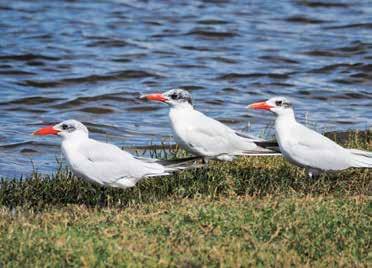
4 minute read
Nature Page
CASPIAN TERN –
Hydroprogne caspa BY MARG WEBBER
Advertisement
Caspian Terns are a common sight roosting by the water’s edge or flying over the Pumicestone Passage, and at Woorim. During the summer months, many of them fly off to their breeding grounds so you are more likely to see them at other times. They are easy to spot as they are the largest tern in the world and can be identified by their very large, red bill. They are 53-58 cm long, weigh 400750 g and have a wingspan of 1.1-1.4 m. Wings are long and legs are short. Their backs and wings are grey and the feathers below are white. As they age their feathers become darker which makes it easier for experts to work out the age of the bird. During the breeding season, they have black caps with small crests on the tops of their heads. These become streaked with white during non-breeding times. Calls are deep and harsh. Male and female are similar in appearance. Their average age is about 12 years. The oldest recorded bird in the world was 32 years. When moving to their breeding grounds they often fly at 80100m above the ground. Habitats are mostly in coastal locations all around Australia. Usually, they stay relatively close to the coastline and do not fly too far out to sea. They do venture inland and are often seen roosting and flying around lakes, dams, lagoons and rivers. I have sometimes seen a small flock roosting at the Spit on Somerset Dam. They are found in every continent in the world except Antarctica. Caspian Terns are usually sedentary but do fly off to breed and to follow sources of food when necessary. Mornings are when they do most of their hunting. They are usually solitary predators and fly with heads pointing downwards looking for food. Fish from salt or freshwater are their main diet which is obtained by diving from about 15m headlong into the water with folded wings. They are often fully submerged when procuring their prey. The food is usually swallowed head first while in flight or taken to the nest to feed their young. Insects such as grasshoppers and dragonflies, the young and eggs of other birds and small animals are also a small part of their diets. Caspian Terns mainly breed in the summer months but given the right conditions may breed at any time of the year. Usually, a new mate is selected each season but sometimes couples remain together for several years. Their courting rituals are interesting in that the male takes a whole fish, flies high overhead with it then presents it to the female of his choice. If she accepts they immediately become a couple and soar together into the air performing tandem aerobatics. Breeding mostly takes place in small colonies but also some breed in solitary pairs. Nests are made on sandy beaches and off-shore islands. These built by both parents are scrapes in the sand sometimes circled


by scattered debris. One to three creamy splotched eggs are laid and incubated for 20-22days by both parents that then look after the young chicks. Babies are fed with whole regurgitated fish. Both parents become noisy and hostile if the nest is threatened by animals or people. To protect the babies from the heat the parents stand over them with wings outstretched creating a shady shelter. Fledging occurs at around 35-45 days but the young birds are fed by their parents for months afterwards sometimes as long as 8 months. Young birds first breed at about 3 years. Their scientific name is taken first from an ancient Greek word – Hudros meaning “water” and a Latin word Progne meaning “swallow”. “Caspa” refers to the Caspian Sea where early ornithologists associated them with the Caspian Sea where they were common. Conservation status is secure in all states except Victoria where it is listed as vulnerable. World population estimated at around 50 000 pairs is probably stable and maybe even increasing a little. Like other shore-nesting birds, babies and eggs are unprotected against fourwheel drives, people and animals on the beach. The mortality rate is high and in some parts is as much as 62%.
Blessing of the Fleet

THE BRIBIE ISLAND SAILING CLUB, TOGETHER WITH AN OUTRIGGER CANOE FROM BIMOCC, WEATHER PERMITTING, WILL BE HOLDING A BLESSING OF THE FLEET CEREMONY FOR THE BOATS IN THEIR CLUB.
Saturday, 30th January 2021, with the boats motoring northwards from Sylvan Beach, past the VMR Pontoon. A Minister from St Peter's Church, Bribie Island, will bless the boats as they pass the pontoon. Members of the public may be interested in observing the proceedings from the waterfront. The ceremony has taken place in the past on Bribie and the BISC is trying to revive this annual event. After the ceremony, the BISC will be sailing off to Mission Point for one of their regular events.








